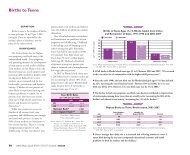2010 Rhode Island Kids Count Factbook
2010 Rhode Island Kids Count Factbook
2010 Rhode Island Kids Count Factbook
Create successful ePaper yourself
Turn your PDF publications into a flip-book with our unique Google optimized e-Paper software.
Homeless Children<br />
DEFINITION<br />
Homeless children is the number of<br />
children under age 18 who stayed at<br />
homeless shelters, domestic violence<br />
shelters, or transitional housing facilities<br />
in <strong>Rhode</strong> <strong>Island</strong> with their families. This<br />
number does not include homeless and<br />
runaway youth who are unaccompanied<br />
by their families.<br />
SIGNIFICANCE<br />
Lack of affordable housing,<br />
unemployment, low-paying jobs, extreme<br />
poverty, and decreasing government<br />
supports all contribute to the problem of<br />
family homelessness. Other causes of<br />
family homelessness include domestic<br />
violence, mental illness, substance abuse,<br />
and the fraying of social support<br />
networks. 1,2,3,4 More than 80% of<br />
homeless mothers with children have<br />
experienced domestic violence. 5<br />
Compared to their peers, homeless<br />
children are more likely to become ill,<br />
develop mental health issues (such as<br />
anxiety, depression, and withdrawal),<br />
experience significant educational<br />
disruption, and exhibit delinquent or<br />
aggressive behaviors. Homeless children<br />
go hungry at twice the rate of other<br />
children and are more likely to<br />
experience illnesses such as stomach<br />
problems, ear infections and asthma. 6,7<br />
Families who have experienced<br />
homelessness have higher rates of family<br />
separation than other low-income<br />
families, with children separated from<br />
their parents due to shelter rules, state<br />
intervention, and parents’ desires to<br />
protect their children from the<br />
homelessness experience. Homeless<br />
children are 12 times more likely to be<br />
placed in foster care than other children.<br />
Homelessness also can be barrier to<br />
reunification for families. Studies suggest<br />
that more than 30% of children in foster<br />
care could return home if their parents<br />
had adequate housing. 8<br />
In <strong>Rhode</strong> <strong>Island</strong>, children in<br />
homeless families made up just over<br />
one-quarter (26%) of the people who<br />
used a shelter or transitional housing<br />
between July 1, 2008 and June 30,<br />
2009. One-half (844) of these 1,676<br />
children were under the age of six. 9<br />
Several forces have contributed to<br />
the high number of families<br />
experiencing homelessness in <strong>Rhode</strong><br />
<strong>Island</strong>, including rising unemployment,<br />
lack of affordable housing, and high<br />
rates of foreclosure. From December<br />
2007 to December 2009, <strong>Rhode</strong><br />
<strong>Island</strong>’s unemployment rate more than<br />
doubled from 6.0% to 12.9%. 10 In<br />
2009, the average rent for a twobedroom<br />
apartment in <strong>Rhode</strong> <strong>Island</strong><br />
was $1,170 or 91% of the monthly<br />
earnings of a full-time worker earning<br />
the minimum wage. 11,12 In 2009, 5,065<br />
properties in <strong>Rhode</strong> <strong>Island</strong> were filed<br />
for foreclosure and many families (both<br />
renters and owners) lost their homes. 13,14<br />
Neighborhood Opportunities Program<br />
◆ Started in Fiscal Year 2001, the Neighborhood Opportunities Program (NOP) was the<br />
first state-funded program for affordable housing in <strong>Rhode</strong> <strong>Island</strong>. When it began, the<br />
program subsidized both the development and operation of affordable housing. Since<br />
2008, NOP funds have been used only to subsidize rents for families with very low<br />
incomes. Families generally pay 30% of their income and the subsidy makes up the<br />
difference between this amount and the total rent. 15,16<br />
◆ The Neighborhood Opportunities Program has helped many homeless families move<br />
into affordable housing and prevented other families from becoming homeless. As of<br />
April 2009, NOP has contributed $41.5 million toward the development and operation<br />
of 1,127 homes in 26 cities and towns. 17,18<br />
Supporting Homeless Children in Schools<br />
◆ Family residential instability and homelessness contribute to poor educational<br />
outcomes for children. Homeless children are more likely to change schools, repeat<br />
grades, and have learning disabilities than children who have housing. 19<br />
◆ The McKinney-Vento Homeless Assistance Act requires that state and local educational<br />
agencies support homeless students by allowing them to enroll in school even if they lack<br />
required documents (such as birth certificates or immunization records), allowing them<br />
to remain in their “home” school district, and providing transportation when needed. 20<br />
◆ The McKinney-Vento Act defines as homeless any child who does not have a “fixed,<br />
regular, and adequate night-time residence.” 21 During the 2008-2009 school year, <strong>Rhode</strong><br />
<strong>Island</strong> public school personnel identified 1,099 children as homeless. Of these children,<br />
57% (622) were living in shelters, 38% (423) were doubled up, 4% (46) were living in<br />
hotels or motels, and 1% (8) were unsheltered. 22<br />
◆ Schools can support homeless families by identifying children and youth experiencing<br />
homelessness, ensuring that families and staff are aware of students’ rights under the<br />
McKinney-Vento Act, developing relationships with community agencies serving homeless<br />
families, and helping homeless children get food, clothing, school supplies, and other<br />
supports they need to succeed in school. 23<br />
30 <strong>2010</strong> <strong>Rhode</strong> <strong>Island</strong> KIDS COUNT <strong>Factbook</strong> / Economic Well-Being






